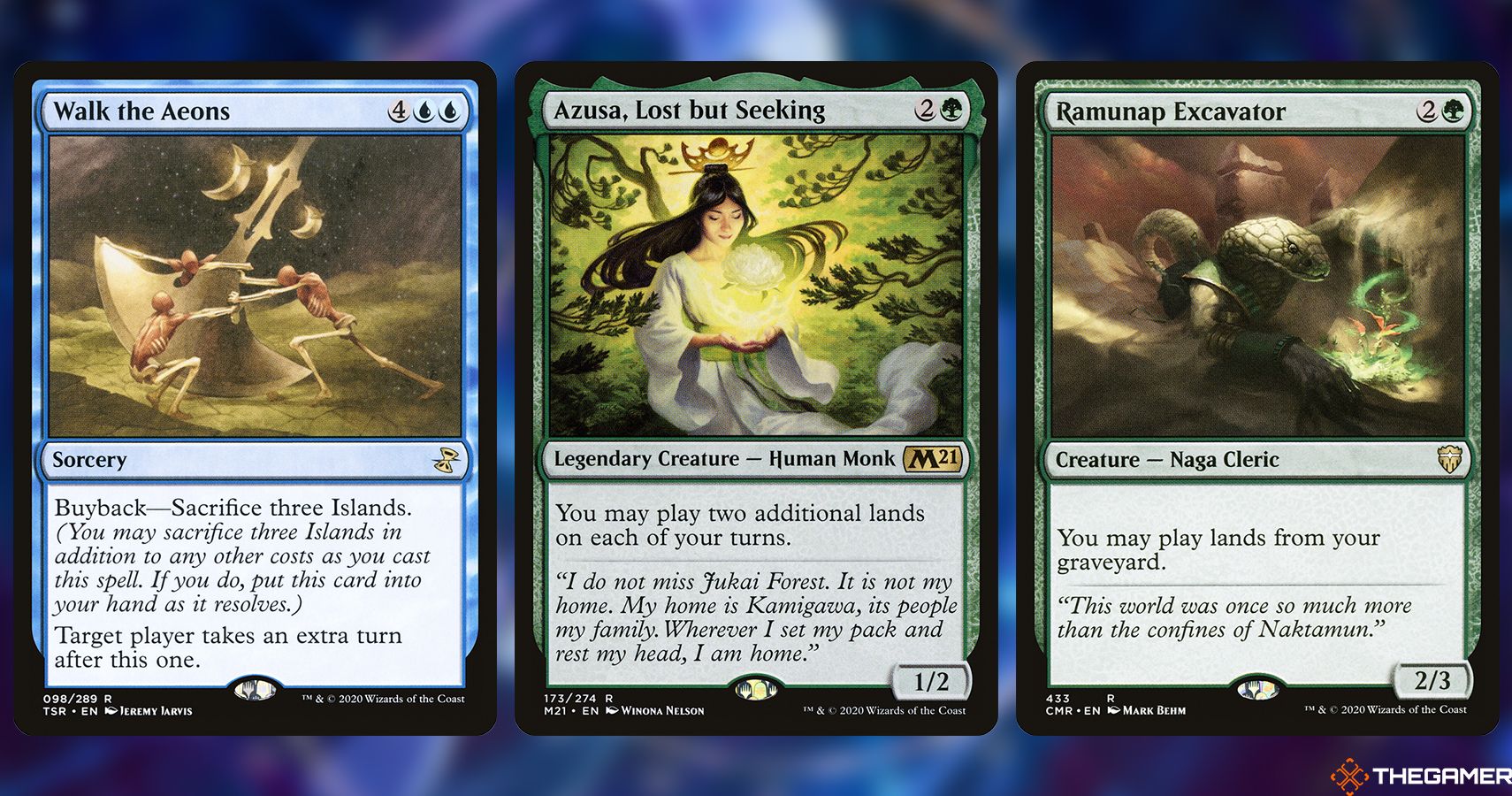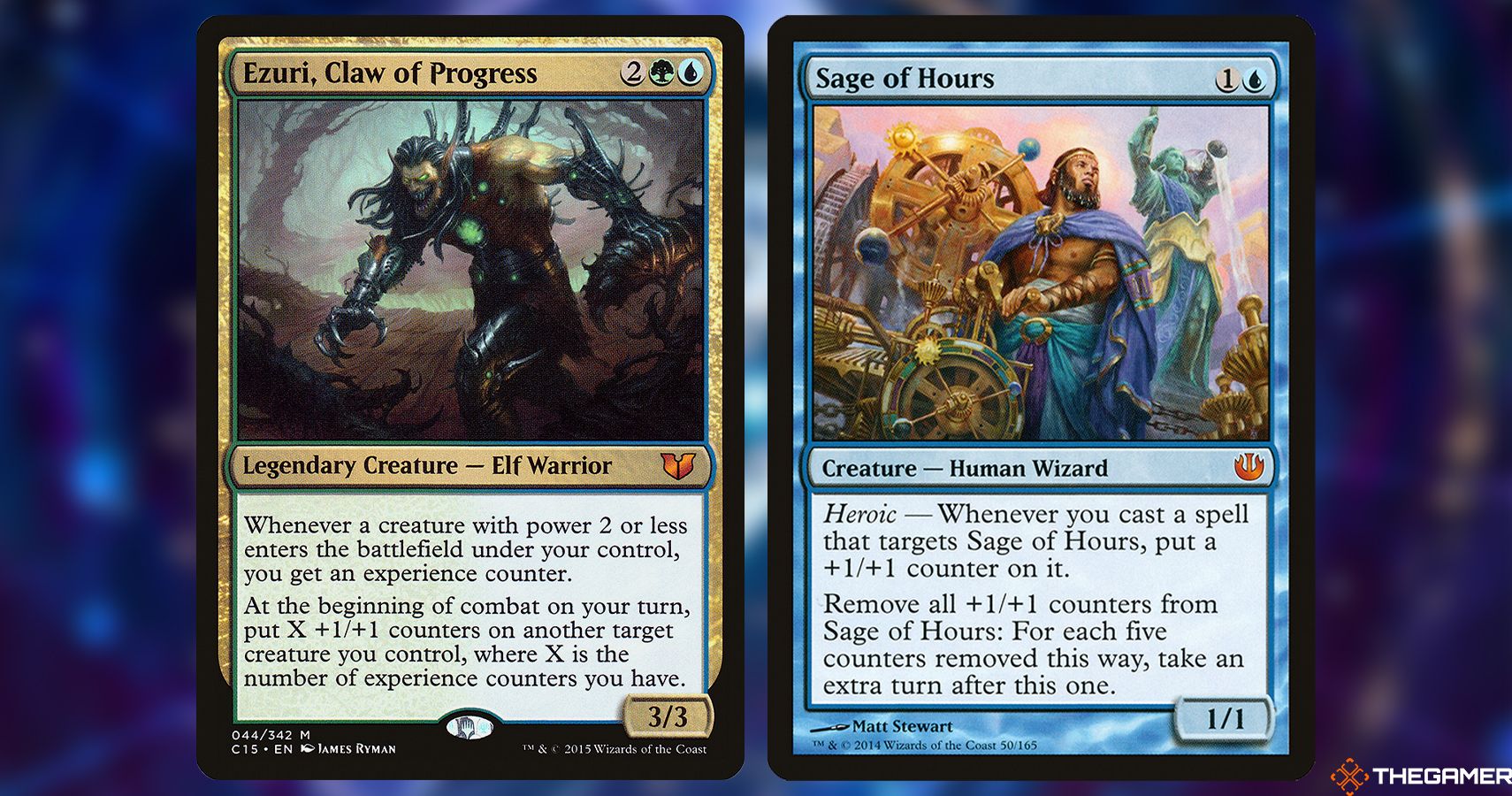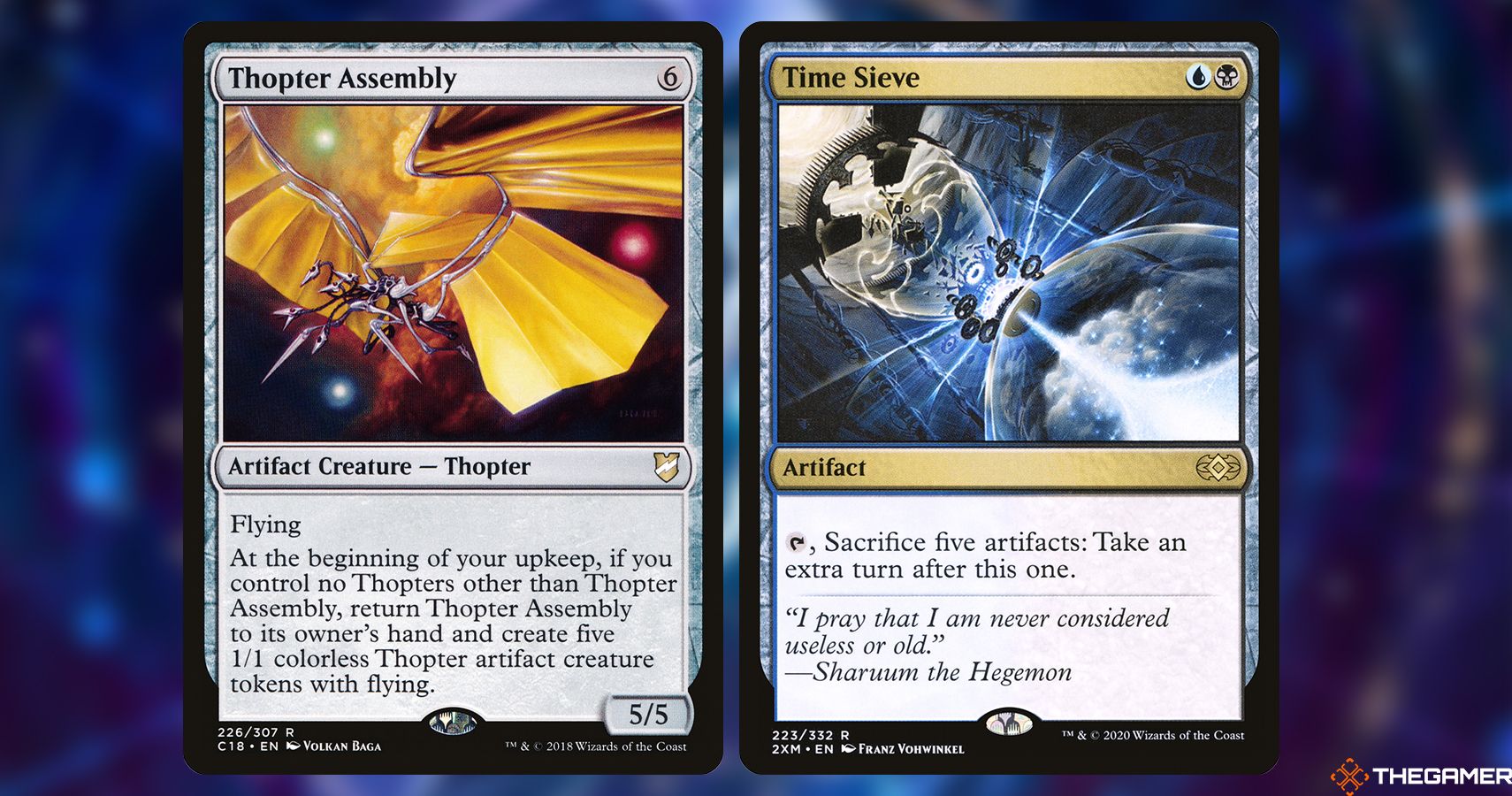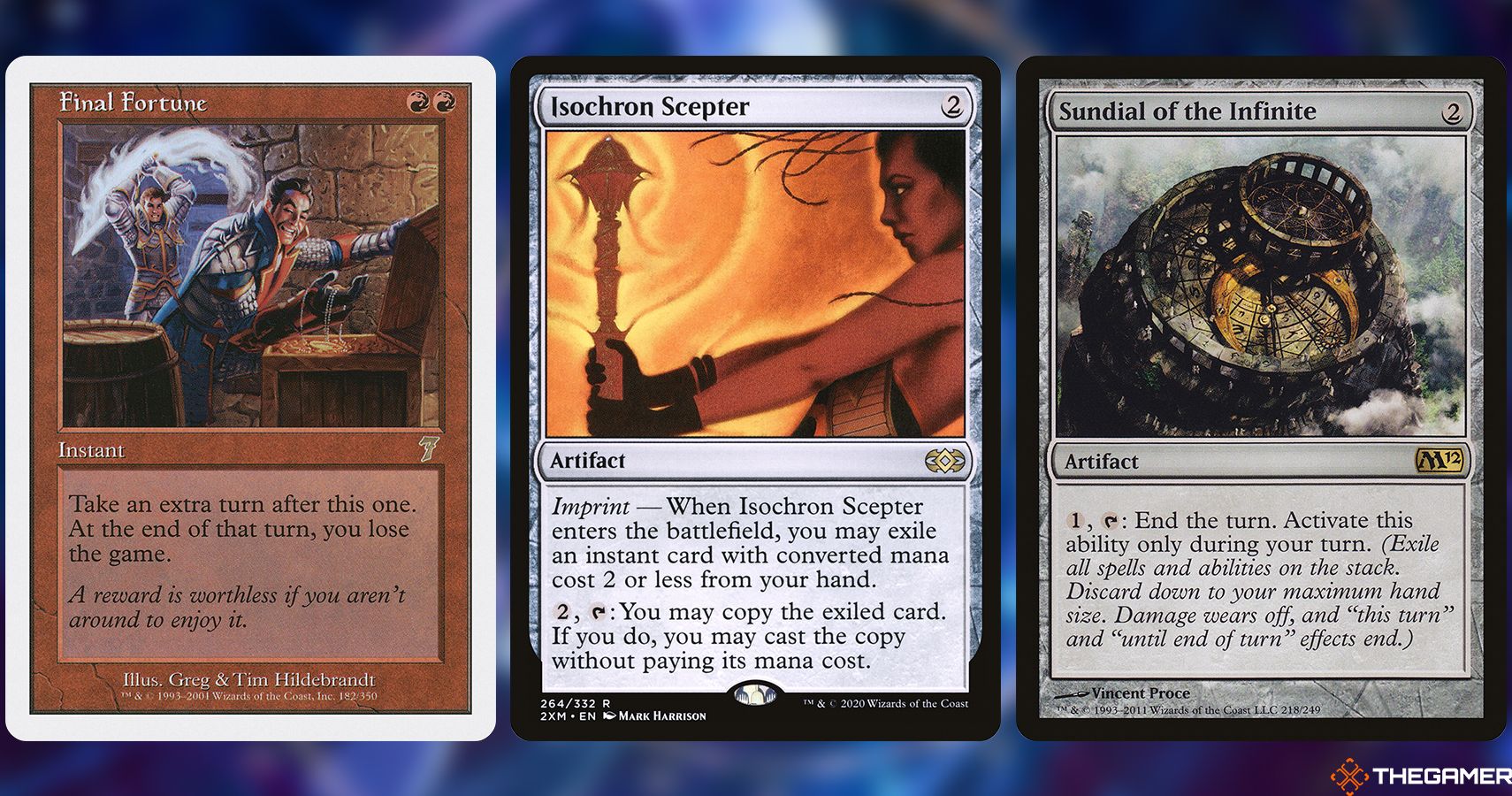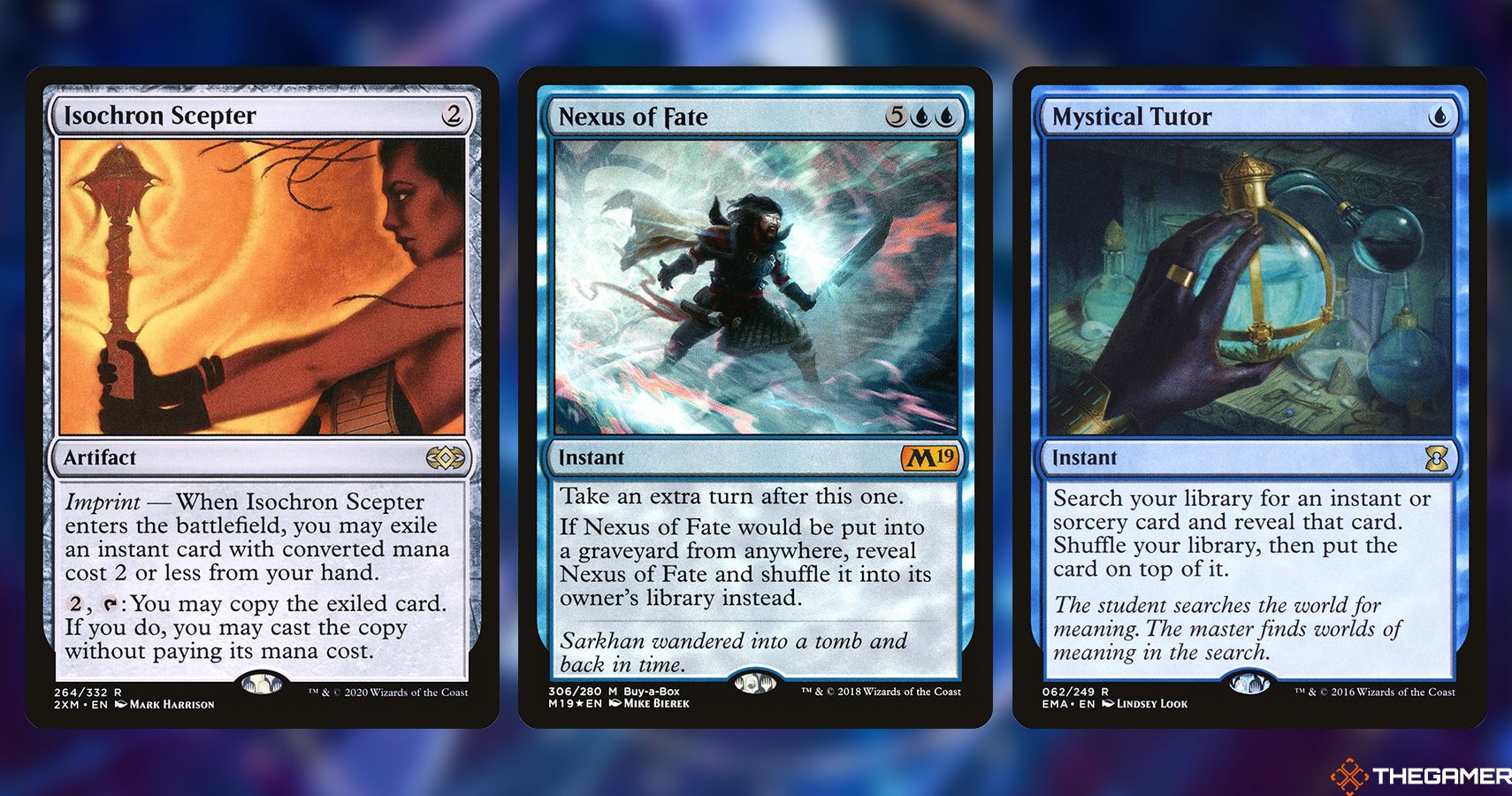In Magic the Gathering, taking an extra turn is great. You get extra card draw, more time to cast spells, more combat, and, most importantly, a long time to build up your strategy before your opponent can knock it all down.
But why take just one turn when you can take infinite turns? Though a controversial move in Commander, infinite turns are almost always a guaranteed win as you'll just keep playing through your deck unimpeded until you have your finishing moves. They're also not that difficult to set up, either. Here are the top five best infinite turn combos for MTG's Commander format.
Note that some combos are very similar to each other, and so they'll be skipped over in favour of combos that can work in many different colour identities. Extra turns are mostly a blue mechanic, but it's surprising how it pops up in other colours as well.
5 Walk the Aeons, Ramunap Excavator, and Azusa, Lost But Seeking
This combo abuses Azusa's ability to let you play an additional two lands every turn to drive its infinite turn engine. It would be excellent in a Simic lands-matter deck, like Tatyova, the Benthic Druid or Aesi, Tyrant of Gyre Strait.
First, have Azusa, Lost But Seeking and Ramunap Excavator, and at least three islands out on the battlefield. Then, go to cast Walk the Aeons to gain your first extra turn, and pay the buyback cost of sacrificing those three islands. This will return Walk the Aeons to your hand and put three lands in your graveyard.
Assuming you've not played any lands this turn yet, you can combine Azusa's ability with Ramunap Excavator's to play those three islands straight out of your graveyard. On your next turn (the extra one), just repeat the process: play Walk the Aeons, sacrifice the three islands to bounce it back to your hand, then play the islands out of your graveyard.
Ramunap Excavator isn't the only card that can do this, but it is by far the cheapest. Ancient Greenwarden and Crucible of Worlds would also work for this.
Though this is a great combo, if you just have Azusa out it does mean you're never going to increase your mana pool. You'll be too busy sacrificing and replaying the same lands to add any more. It's a good idea to either do it when you have a large number of lands out in play already, or run more extra lands cards like Exploration, Burgeoning, or Dryad of the Ilysian Grove.
4 Sage of Hours, and Ezuri, Claw of Progress
Another Simic combo, this one is great because it's a one-card combo using a potential Commander, the Phyrexian Elf Ezuri, Claw of Progress.
For this combo to work, you need Sage of Hours and Ezuri both out on the battlefield, and you may have collected at least five experience counters through Ezuri's ability.
At the beginning of combat on your first turn, Ezuri's ability triggers, and you can put at least five +1/+1 counters on a creature. Put the counters on Sage of Hours, and then immediately sacrifice them all with its ability to get an extra turn.
That's all you have to do. Every turn put the +1/+1 counters from Ezuri's ability back on to Sage of Hours, sacrifice them, take an extra turn. If you've got more than five counters each turn, you could even trigger Sage of Hours multiple times to build up your +1/+1 counters even further.
The best thing about this combo is that it doesn't use up any of your resources like the Azusa and Walk the Aeons combo. It requires no repeated mana input to work, giving you the room to really progress your game plan.
3 Thopter Assembly, and Time Sieve
Another two-card combo, this time it uses an artifact producer with dimir Time Sieve to give you endless turns.
Both Time Sieve and Thopter Assembly have to be on the battlefield, and Thopter Assembly can be the only Thopter you control. You also need six generic mana free each turn.
At the start of your upkeep, Thopter Assembly will trigger, creating five 1/1 Thopter artifact creature tokens and bouncing Thopter assembly back to your hand. Tap time Sieve and sacrifice all five of those Thopters to it, granting you your first extra turn. Before the end of your first turn, make sure you've paid the six generic mana to recast Thopter Assembly, as it has to be out at the start of your next turn's upkeep.
At the start of your first extra turn, the same thing will happen. Thopter Assembly will make five tokens and bounce back to your hand, Time Sieve will sacrifice those tokens for an extra turn, and you'll be able to pay the six generic mana to recast Thopter Assembly.
This is a fantastic combo. The only reasons it isn't higher are because it requires a costly six mana each turn to pull off, eating into resources you could be spending winning, and because needing two colours in your colour identity limits the decks it could fit into.
2 Final Fortune, Isochron Scepter, Sundial of the Infinite
Extra turns are almost universally associated with blue, and so having an infinite turns combo in mono-red is immediately appealing.
To explain how this combo works, you need to understand a couple of things. First, Final Fortune doesn't technically do what it says on the card anymore: instead of losing the game at the end of the turn, you lose the game at the next end step. Despite the name, the end step isn't the end of the turn, as it's followed by the cleanup step before the next player's turn begins.
Next, some cards can simply 'end the turn'. Cards like Obeka, Brute Chronologist or Sundial of the Infinite let you do this, and when you do, the turn immediately comes to an end there and then. This means the end step is completely skipped, allowing you to circumvent end step triggers, like Final Fortune's.
For the combo, you need Sundial of the Infinite on the battlefield and at least four generic mana available. You'll also need Final Fortune and Isochron Scepter in your hand. First, cast Isochron Scepter and imprint it with Final Fortune. Then pay the two generic mana to trigger Isochron Scepter and cast a copy of Final Fortune. You've now got your first extra turn.
Carry on your first turn as normal, and then progress into your first extra turn. Pay two generic mana and re-activate Isochron Scepter to cast another Final Fortune. Making sure you've always got one generic mana open, continue your extra turn until the end of your second main phase.
Before ending your second main phase and moving to your end step – where Final Fortune would make you lose – activate Sundial of the Infinite to end the turn. This skips the end step and prevents you from losing with Final Fortune, and you'll simply move on to your next extra turn.
You can do this as many times as you want: pay two generic mana to activate Isochron Scepter and cast a Final Fortune, then end the turn early with Sundial of the Infinite before you lose.
1 Nexus of Fate, Isochron Scepter, and Mystical Tutor
Though this combo also uses Isochron Scepter, it works very differently from the mono-red one.
For this one, you need seven generic and two blue mana open every turn. You also need an additional two on the first turn of the combo to cast Isochron Scepter. While that is a lot, blue has access to cards like Sphinx of the Second Sun or Dramatic Reversal, meaning it isn't as big of a drawback as you might expect. You also need Nexus of Fate, Isochron Scepter and Mystical Tutor all in your hand.
First, cast Isochron Scepter for two generic and imprint it with Mystical Tutor. Then, cast Nexus of Fate to take an extra turn. When Nexus of Fate resolves, instead of going to the graveyard, it is instead shuffled into your library.
From there, you can pay the two generic to activate Isochron Scepter and cast a copy of Mystical Tutor to search for the Nexus of Fate and put it back into your hand. On your first extra turn, do it again: cast Nexus of Fate for an extra turn, then tutor it back out of your library with Mystical Tutor.
Another reason why this combo is so great is because it's tricky to interact with. Nexus of Fate just goes to your library rather than the graveyard, making most counterspells useless against it. The only real way to derail your combo is for an opponent to destroy Isochron Scepter or counter Nexus of Fate with an exiling card like Faerie's Trickery. Anything else and you can pick up where you left off on the next turn.


